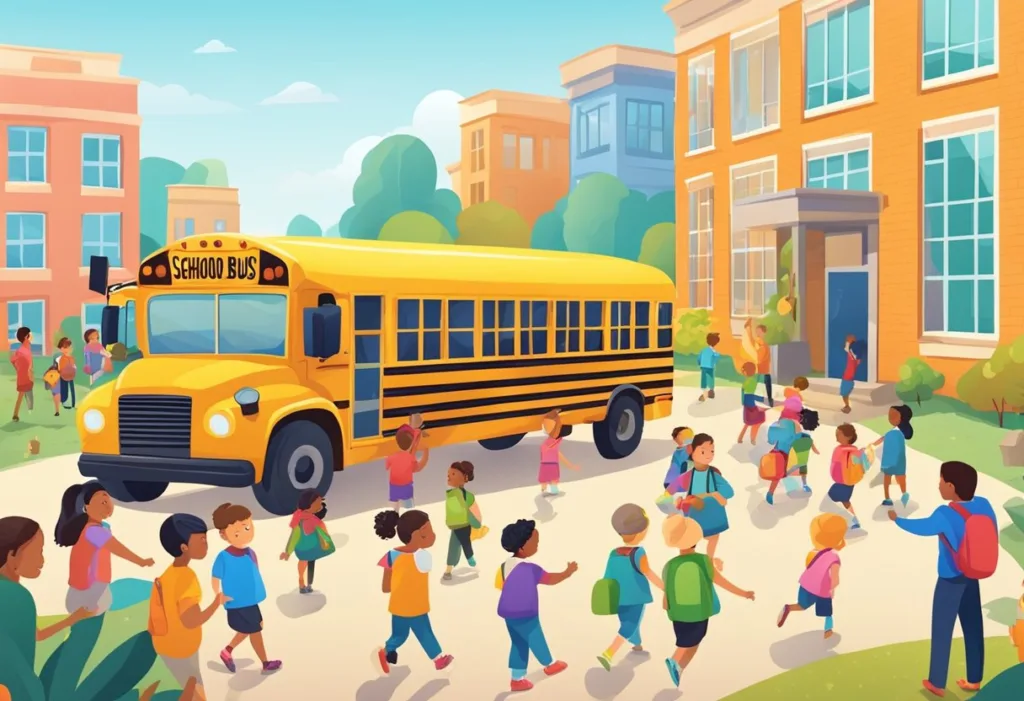Augmented Reality (AR) is a technology that overlays digital information such as sounds, videos, and graphics on top of the real-world environment. This technology has become increasingly popular in various industries, including education. AR has the potential to revolutionize the way students learn by creating interactive and engaging experiences that enhance their understanding of complex concepts. In this article, I will discuss AR for schools and share the benefits of augmented reality for students and educators alike.
Implementing AR in classrooms is a great way to engage students and make learning more interactive. AR can be used to bring abstract concepts to life, provide students with a more immersive learning experience, and help them retain information better. AR resources for educators are readily available, making it easy for teachers to integrate this technology into their lesson plans.
AR for schools is an exciting new development that has the potential to transform the way students learn. Interactive learning with AR can make education more engaging and effective, and assessment and research have shown promising results. With the right technological infrastructure in place, schools can successfully implement AR and create a more dynamic learning environment for their students.
What is an AR for school?
Augmented Reality (AR) is a technology that overlays digital information onto the real world, creating an interactive and immersive experience. In schools, AR can be used to enhance the learning experience by providing students with a visual representation of abstract concepts. AR for schools can be accessed through smartphones, tablets, or AR headsets.
Role of AR for Students
AR for students can increase engagement and understanding of complex concepts. By providing a visual representation of abstract concepts, AR can help students grasp difficult concepts more easily. AR can also help students develop critical thinking and problem-solving skills by presenting them with real-world scenarios that require them to apply their knowledge.
Role of AR for Schools and Educators
AR for schools and educators can help to create a more dynamic and interactive learning environment. AR can be used to create engaging and interactive lessons that capture students’ attention and increase their motivation to learn. AR can also be used to create personalized learning experiences that cater to the individual needs of each student. In addition, AR can help educators to assess student understanding in real-time by providing them with immediate feedback. This feedback can be used to adjust lessons and activities to better meet the needs of each student.
AR for schools has the potential to revolutionize the way we teach and learn by providing a more engaging, interactive, and personalized learning experience. By incorporating AR into the classroom, educators can create a more dynamic and immersive learning environment that enhances student engagement and understanding of complex concepts.
Benefits of AR for schools and students
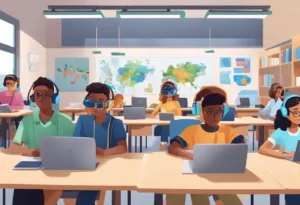
- Interactive Learning Environments
- Enhanced Understanding of Complex Concepts
- Increased Student Engagement
- Personalized Learning Experiences
- Safe Simulation of Dangerous Experiments
- Encouragement of Collaboration and Teamwork
- Support for Students with Different Learning Abilities
- Efficient Use of Educational Resources
- Improved Spatial Awareness and Motor Skills
- Preparation for Future Technological Proficiency
Interactive Learning Environments
Augmented Reality (AR) creates interactive learning environments that transform the classroom experience. By superimposing digital information onto the real world, AR allows students to interact with their surroundings in a way that is both engaging and educational. This interaction promotes active learning and participation, as students are no longer passive recipients of information but rather active explorers of content. For example, an AR-enhanced lesson on astronomy can turn a simple classroom into a virtual observatory, where students can explore the solar system hands-on.
Enhanced Understanding of Complex Concepts
AR has the unique capability to enhance students’ understanding of complex concepts by visualizing them in a three-dimensional space. This is particularly beneficial in subjects like science, engineering, and mathematics, where spatial relationships and abstract ideas can be difficult to grasp through traditional 2D diagrams and text. With AR, students can manipulate models of molecular structures, engineering components, or geometric shapes, providing a deeper and more intuitive comprehension of intricate subjects.
Increased Student Engagement
The immersive nature of AR technology significantly increases student engagement. When lessons are augmented with interactive and visually stimulating content, students are more likely to pay attention and participate. This heightened engagement can lead to better attendance rates, lower dropout rates, and overall more enthusiastic learners. Engaged students are also more likely to retain information and develop a passion for learning, which can have long-term educational benefits.
Personalized Learning Experiences
AR enables personalized learning experiences by allowing educators to tailor content to the needs and interests of individual students. With AR applications, lessons can be adapted to suit different learning speeds, styles, and preferences, making education more inclusive and effective. Personalized learning helps ensure that all students can learn in a way that is best for them, potentially leading to better academic outcomes and increased confidence in their abilities.
Safe Simulation of Dangerous Experiments
In subjects like chemistry and physics, some experiments can be too dangerous, expensive, or impractical to conduct in a school setting. AR provides a safe environment for students to simulate these experiments without the associated risks. They can witness chemical reactions, electrical currents, or mechanical functions in a controlled virtual space, gaining practical experience and knowledge without any physical danger.
Encouragement of Collaboration and Teamwork
AR applications often require students to work together to solve problems or explore scenarios, which fosters collaboration and teamwork. These skills are essential for success in both academic and professional environments. By working with peers in an AR-enhanced setting, students learn to communicate effectively, delegate tasks, and support each other’s learning, which can strengthen social bonds and enhance the educational experience.
Support for Students with Different Learning Abilities
AR can be a valuable tool for supporting students with different learning abilities, including those with disabilities or special educational needs. By providing multisensory experiences and customizable interfaces, AR can cater to a wide range of learners, including visual, auditory, and kinesthetic. This inclusivity ensures that all students have access to educational opportunities that respect their individual needs and abilities.
Efficient Use of Educational Resources
Implementing AR in schools can lead to more efficient use of educational resources. Digital AR content can be updated and distributed with ease, reducing the need for physical materials that wear out and become outdated. This not only saves costs but also allows for quick adaptation to new curricula or educational standards, ensuring that students have access to the most current and relevant information.
Improved Spatial Awareness and Motor Skills
AR applications often require students to interact with virtual objects in a physical space, which can improve spatial awareness and motor skills. These skills are crucial for subjects that involve design, architecture, or physical sciences. Through AR, students can practice manipulating and positioning objects in a 3D environment, enhancing their ability to understand and navigate the space around them.
Preparation for Future Technological Proficiency
As technology continues to advance and become more integrated into every aspect of life, including the workforce, students must be prepared to work with emerging technologies. AR in education familiarizes students with cutting-edge technology, equipping them with the skills and confidence to navigate a digital future. This early exposure ensures that students are not only consumers of technology but also competent creators and innovators, ready to contribute to the technological advancements of tomorrow.
Implementing AR in Classrooms
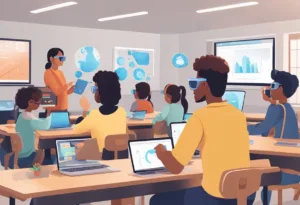
Augmented Reality (AR) technology can be a valuable tool in enhancing the learning experience for students. By overlaying digital elements onto real-world objects, AR can make complex concepts more accessible and engaging, leading to increased student engagement and understanding.
Choosing the Right Tools
When implementing AR in the classroom, it is important to choose the right tools that align with your lesson objectives. There are various AR tools and apps available that can be used for different purposes. For example, Merge Cube is a popular AR tool that allows students to explore various topics such as the water cycle, fossils, and simple machines. Another tool is AR Flashcards, which can be used to teach young students about animals, shapes, and colors.
To choose the right tool, consider the subject matter and the age group of your students. Also, ensure that the tool is easy to use and understand. Providing clear instructions and resources can help students navigate the tool effectively.
Integration Strategies
Integrating AR into your lesson plans can be done in various ways. One strategy is to use AR as a supplement to traditional teaching methods. For example, you can use AR to provide visual aids or to demonstrate complex concepts that are difficult to explain with words alone. Another strategy is to use AR as a standalone lesson. For instance, you can have students use AR tools to explore a specific topic or to complete a project. This can be a great way to encourage creativity and critical thinking skills.
When integrating AR into your classroom, it is important to ensure that it aligns with your curriculum and lesson objectives. Providing resources and support for educators can help ensure successful implementation.
Implementing AR in the classroom can be a valuable tool in enhancing the learning experience for students. By choosing the right tools and integrating it effectively into your lesson plans, you can create an engaging and interactive learning environment for your students.
AR Resources for Educators
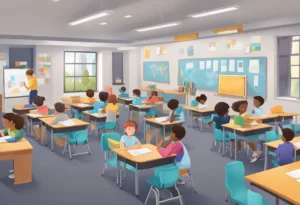
If you’re an educator looking to incorporate augmented reality (AR) into your classroom, there are a variety of resources available to help you get started. Here are a few resources that you may find useful:
Arkansas Department of Education Initiatives
The Arkansas Department of Education (ADE) is committed to providing educators with the resources they need to succeed. As part of this commitment, the ADE has launched several initiatives aimed at helping educators incorporate AR technology into their classrooms.
One such initiative is the ADE’s AR in Education program, which provides educators with training and support to help them effectively integrate AR technology into their curriculum. The ADE has partnered with several organizations to provide educators with access to AR resources, including the Arkansas Discovery Network and the Arkansas STEM Coalition.
Professional Development
To effectively incorporate AR technology into your curriculum, it’s important to have a solid understanding of how the technology works and how it can be used to enhance student learning. To that end, there are a variety of professional development opportunities available to educators looking to learn more about AR technology.
These opportunities include conferences, workshops, and online courses. Some popular options include the International Society for Technology in Education (ISTE) Conference, the AR in Action Conference, and the Coursera Augmented Reality for Everyone course.
In addition to these resources, there are also a variety of AR apps and tools available that can help educators create engaging and interactive learning experiences for their students. Some popular options include 3DBear, Assemblr, and AR Moon-Explore Solar System. By taking advantage of these resources and tools, you can help ensure that your students are getting the most out of their AR learning experiences.
Interactive Learning with AR in Schools
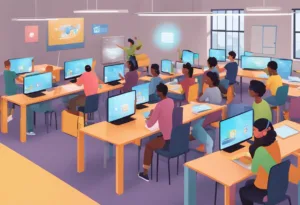
Augmented Reality (AR) is revolutionizing education by providing interactive learning experiences that enhance conceptual understanding and foster collaboration. AR allows students to interact with digital objects and concepts, making the learning process more engaging and memorable.
Enhancing Conceptual Understanding
AR apps can help students better understand complex concepts such as acids and oxides. For example, Chem101 AR allows students to interact with virtual chemical compounds and see how they react in real-time. This interactive learning experience helps students to visualize abstract concepts and make connections between theory and practice.
AR can also be used to enhance language learning by providing interactive experiences that allow students to practice their language skills in real-world contexts. For example, AR apps can provide virtual scenarios that simulate real-life conversations, allowing students to practice their language skills in a safe and controlled environment.
Fostering Collaboration
AR can also be used to foster collaboration among students by providing shared learning experiences. For example, AR apps can allow students to work together on a virtual project, such as building a virtual city or designing a virtual product. This collaborative learning experience helps students to develop teamwork and communication skills, which are essential for success in the modern workplace.
AR can also be used to create interactive presentations that engage students and encourage participation. For example, AR apps can provide virtual quizzes and games that allow students to compete against each other and test their knowledge. This interactive learning experience helps to keep students engaged and motivated, which can lead to better learning outcomes.
AR is a powerful tool for enhancing the learning experience by providing interactive learning experiences that engage students and foster collaboration. By using AR in the classroom, you can create a more dynamic and engaging learning environment that helps students to develop the skills they need to succeed in the modern world.
Assessment and Research
Augmented Reality (AR) has become a popular technology in the education sector. It has been used to enhance learning outcomes and student engagement. Measuring student engagement is crucial in determining the effectiveness of AR in education.
Measuring Student Engagement
Measuring student engagement is important in determining the impact of AR on learning outcomes. The use of AR can increase student engagement by providing an interactive and immersive learning experience. It is important to assess the level of student engagement to determine the effectiveness of AR in education.
One way to measure student engagement is through the use of surveys. Surveys can be used to gather feedback from students on their experience with AR. This feedback can be used to improve the use of AR in education. AR can be used to track student engagement by monitoring their interactions with AR content.
Efficacy of AR in Education
Research has shown that AR can enhance learning outcomes in both K-12 and higher education settings. However, it is important to note that the efficacy of AR in education may vary depending on factors such as student readiness, grades, and assessment.
Research has shown that AR can improve student readiness by providing a hands-on learning experience. AR can also be used to improve student grades by providing interactive and engaging content. Furthermore, AR can be used as an assessment tool to measure student learning outcomes.
Measuring student engagement and assessing the efficacy of AR in education is crucial in determining its impact on learning outcomes. AR can enhance learning outcomes in both K-12 and higher education settings. However, it is important to consider factors such as student readiness, grades, and assessment when implementing AR in education.
Technological Infrastructure
When it comes to implementing augmented reality (AR) in schools, having the right technological infrastructure in place is crucial. This includes both hardware and software requirements, as well as IT support and maintenance.
Hardware and Software Requirements
To ensure that AR is running smoothly in your school, it is important to have the right hardware and software in place. This includes devices such as tablets or smartphones with AR capabilities, as well as headsets or glasses that can provide a fully immersive experience.
In addition to hardware, having the right software is also important. This includes AR apps and platforms that can be used for educational purposes. Some popular options include Google Expeditions, Merge Cube, and CoSpaces Edu.
IT Support and Maintenance
Once the hardware and software are in place, it is important to have IT support and maintenance to ensure that everything is running smoothly. This includes regular updates and maintenance of devices and software, as well as troubleshooting any issues that may arise.
Having a dedicated IT support team can help ensure that any problems are addressed quickly and efficiently, minimizing any disruptions to the learning process. It is also important to have a plan in place for replacing or upgrading hardware and software as needed.
Case Studies and Success Stories
Schools Implementing AR
Many schools around the world have already implemented AR in their classrooms and have reported positive outcomes. For example, in a case study conducted by the University of Helsinki, students who were taught with AR technology scored higher in their exams compared to those who were taught through traditional methods. Another success story comes from Singapore, where the Ministry of Education has implemented AR in their curriculum to enhance the learning experience for their students.
Impact on Student Outcomes
The impact of AR on student outcomes has been significant. According to a study conducted by the University of Central Florida, students who were taught with AR technology showed a 35% increase in retention rates compared to those who were taught through traditional methods. AR has been found to increase student engagement and motivation, as it provides a more interactive and immersive learning experience.
Furthermore, AR has been used to support students with special needs. In a case study conducted by the University of Granada, AR was used to help students with autism improve their social skills. The study found that the use of AR technology significantly improved the students’ social interaction and communication skills.
AR technology has proven to be a valuable tool for schools to enhance the learning experience of their students. With its ability to increase engagement, motivation, and retention rates, AR is a technology that is here to stay. As more schools continue to implement AR in their classrooms, we can expect to see even more success stories and positive outcomes in the future.
Frequently Asked Questions
Why are AR services required in school settings?
Augmented Reality (AR) services are required in school settings to provide an immersive and interactive learning experience to students. AR technology allows students to visualize and interact with complex concepts in a more engaging way, making learning more fun and effective. AR also helps students to retain information better as they can visualize and interact with it.
How can AR be used in the classroom?
AR can be used in the classroom to enhance learning and make it more interactive. Teachers can use AR to create 3D models of complex concepts such as the human body, solar system, or historical events. Students can interact with these models to better understand the concepts. AR can also be used to create simulations and games that make learning more fun and engaging.
What is an example of AR in teaching?
An example of AR in teaching is the use of AR apps to teach math concepts. Teachers can use AR apps to create 3D models of geometric shapes, which students can interact with to learn about their properties. AR can also be used to create simulations of real-world scenarios, such as the stock market, to teach financial literacy.
What are the cons of augmented reality in education?
One of the cons of augmented reality in education is the cost of the technology. AR technology can be expensive, and not all schools may have the budget to invest in it. Another con is the need for training and support for teachers to effectively use AR in the classroom. Some students may find AR technology distracting and may not be able to focus on learning.
What is the difference between VR and AR?
Virtual Reality (VR) is a technology that creates a completely immersive experience, where users are transported to a different environment. Augmented Reality (AR), on the other hand, overlays digital content onto the real world. While VR creates a completely new environment, AR enhances the real world with digital content.
Do you use AR or VR for your learning?
As an AI language model, I do not use AR or VR for learning. However, AR and VR are becoming increasingly popular in education as they provide an immersive and interactive learning experience. Many schools and universities are adopting AR and VR technology to enhance learning and make it more engaging.

